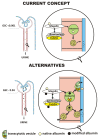Renal Handling of Albumin-From Early Findings to Current Concepts
- PMID: 34071680
- PMCID: PMC8199105
- DOI: 10.3390/ijms22115809
Renal Handling of Albumin-From Early Findings to Current Concepts
Abstract
Albumin is the main protein of blood plasma, lymph, cerebrospinal and interstitial fluid. The protein participates in a variety of important biological functions, such as maintenance of proper colloidal osmotic pressure, transport of important metabolites and antioxidant action. Synthesis of albumin takes place mainly in the liver, and its catabolism occurs mostly in vascular endothelium of muscle, skin and liver, as well as in the kidney tubular epithelium. Long-lasting investigation in this area has delineated the principal route of its catabolism involving glomerular filtration, tubular endocytic uptake via the multiligand scavenger receptor tandem-megalin and cubilin-amnionless complex, as well as lysosomal degradation to amino acids. However, the research of the last few decades indicates that also additional mechanisms may operate in this process to some extent. Direct uptake of albumin in glomerular podocytes via receptor for crystallizable region of immunoglobulins (neonatal FC receptor) was demonstrated. Additionally, luminal recycling of short peptides into the bloodstream and/or back into tubular lumen or transcytosis of whole molecules was suggested. The article discusses the molecular aspects of these processes and presents the major findings and controversies arising in the light of the research concerning the last decade. Their better characterization is essential for further research into pathophysiology of proteinuric renal failure and development of effective therapeutic strategies.
Keywords: albumin; cubilin; megalin; proteinuria; renal catabolism of proteins; renal proximal tubule.
Conflict of interest statement
The authors declare no conflict of interest.
Figures


Similar articles
-
[Renal catabolism of albumin - current views and controversies].Postepy Hig Med Dosw (Online). 2011 Oct 27;65:668-77. doi: 10.5604/17322693.964329. Postepy Hig Med Dosw (Online). 2011. PMID: 22100800 Review. Polish.
-
Reduced proximal tubular expression of protein endocytic receptors in proteinuria is associated with urinary receptor shedding.Nephrol Dial Transplant. 2018 Jun 1;33(6):934-943. doi: 10.1093/ndt/gfx321. Nephrol Dial Transplant. 2018. PMID: 29186471
-
Cubilin- and megalin-mediated uptake of albumin in cultured proximal tubule cells of opossum kidney.Kidney Int. 2000 Oct;58(4):1523-33. doi: 10.1046/j.1523-1755.2000.00314.x. Kidney Int. 2000. PMID: 11012887
-
Abolishment of proximal tubule albumin endocytosis does not affect plasma albumin during nephrotic syndrome in mice.Kidney Int. 2018 Feb;93(2):335-342. doi: 10.1016/j.kint.2017.07.024. Epub 2017 Oct 14. Kidney Int. 2018. PMID: 29032953
-
Albumin uptake and processing by the proximal tubule: physiological, pathological, and therapeutic implications.Physiol Rev. 2022 Oct 1;102(4):1625-1667. doi: 10.1152/physrev.00014.2021. Epub 2022 Apr 4. Physiol Rev. 2022. PMID: 35378997 Free PMC article. Review.
Cited by
-
The association between albumin and C-reactive protein in older adults.Medicine (Baltimore). 2023 Aug 25;102(34):e34726. doi: 10.1097/MD.0000000000034726. Medicine (Baltimore). 2023. PMID: 37653773 Free PMC article.
-
Utility of a novel point-of-care test for albuminuria in communities at high risk for chronic kidney disease in Thailand.BMJ Public Health. 2025 Jan 16;3(1):e001412. doi: 10.1136/bmjph-2024-001412. eCollection 2025. BMJ Public Health. 2025. PMID: 40017920 Free PMC article.
-
To treat or not to treat: CUBN-associated persistent proteinuria.Kidney Res Clin Pract. 2024 Sep;43(5):663-670. doi: 10.23876/j.krcp.23.258. Epub 2024 Aug 24. Kidney Res Clin Pract. 2024. PMID: 39390623 Free PMC article.
-
Albumin influences leucocyte FcRn expression in the early days of kidney transplantation.Clin Exp Immunol. 2024 May 16;216(3):307-317. doi: 10.1093/cei/uxae011. Clin Exp Immunol. 2024. PMID: 38353127 Free PMC article.
-
Cadmium-Induced Proteinuria: Mechanistic Insights from Dose-Effect Analyses.Int J Mol Sci. 2023 Jan 18;24(3):1893. doi: 10.3390/ijms24031893. Int J Mol Sci. 2023. PMID: 36768208 Free PMC article.
References
-
- Miller A., Jędrzejczak W.W. Albumina—Funkcje biologiczne i znaczenie kliniczne. Postępy Hig. Med. Dośw. 2001;55:17–36. - PubMed
-
- Peters J.T. All About Albumin: Biochemistry, Genetics and Medical Applications. Academic Press; San Diego, CA, USA: 1996.
Publication types
MeSH terms
Substances
LinkOut - more resources
Full Text Sources

